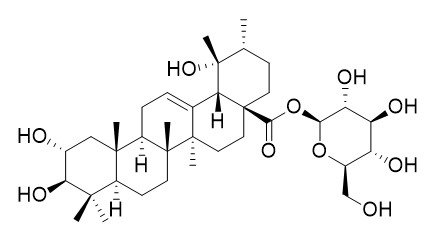Rosamultin
Rosamultin has antioxidant, antiinflammatory/antinociceptive properties, it may protect against bromobenzene-induced hepatotoxicity through, at least in part, enhanced activity of epoxide hydrolase. Rosamultin has anti-human immunodeficiency virus (HIV) activity, it inhibited HIV-1 protease by 53% at a concentration of 100 microM.
Inquire / Order:
manager@chemfaces.com
Technical Inquiries:
service@chemfaces.com
Tel:
+86-27-84237783
Fax:
+86-27-84254680
Address:
1 Building, No. 83, CheCheng Rd., Wuhan Economic and Technological Development Zone, Wuhan, Hubei 430056, PRC
Providing storage is as stated on the product vial and the vial is kept tightly sealed, the product can be stored for up to
24 months(2-8C).
Wherever possible, you should prepare and use solutions on the same day. However, if you need to make up stock solutions in advance, we recommend that you store the solution as aliquots in tightly sealed vials at -20C. Generally, these will be useable for up to two weeks. Before use, and prior to opening the vial we recommend that you allow your product to equilibrate to room temperature for at least 1 hour.
Need more advice on solubility, usage and handling? Please email to: service@chemfaces.com
The packaging of the product may have turned upside down during transportation, resulting in the natural compounds adhering to the neck or cap of the vial. take the vial out of its packaging and gently shake to let the compounds fall to the bottom of the vial. for liquid products, centrifuge at 200-500 RPM to gather the liquid at the bottom of the vial. try to avoid loss or contamination during handling.
Asian J Beauty Cosmetol2022, 20(2):183-191
FASEB J.2022, 36(7):e22387.
J. Food Composition and Analysis2022, 114:104731
Int J Mol Sci.2019, 20(3):E651
Appl. Sci. 2021, 11(17),7829
Herbal Formula Science2024, 32(3):203-221
The Malaysian journal of pathology2019, 41(3):243-251
Molecules.2023, 28(8):3291.
J.Soc.Cosmet.Sci.Korea2024, 50(3): 261-270
J Food Sci.2021, 86(9):3810-3823.
Related and Featured Products
J Med Food. 2005 Spring;8(1):107-9.
Anti-HIV protease activity from rosa family plant extracts and rosamultin from Rosa rugosa.[Pubmed:
15857219 ]
METHODS AND RESULTS:
To identify substances with anti-human immunodeficiency virus (HIV) activity from plant sources, 12 extracts of Rosa family plants were screened for their inhibitory effects against HIV-1 protease. Of the extracts tested, the strongest inhibitory effects were observed in the root of Rosa rugosa and the leaves of Prunus sargentii, at a concentration of 100 microg/mL.
CONCLUSIONS:
Rosamultin isolated from the root of R. rugosa inhibited HIV-1 protease by 53% at a concentration of 100 microM.
Biol Pharm Bull. 2005 Jan;28(1):101-4.
19Alpha-hydroxyursane-type triterpenoids: antinociceptive anti-inflammatory principles of the roots of Rosa rugosa.[Pubmed:
15635171]
To search for antiinflammtory 19alpha-hydroxyursane-type triterpenoids, the MeOH extract of the roots of Rosa rugosa (Rosaceae) was fractionated.
METHODS AND RESULTS:
The active fraction of the EtOAc extract was hydrolyzed in alkaline solution to give a hydrolyzed fraction. Both extracts showed antiinflammatory/antinociceptive action in acetic acid-induced writhing and hot plate testing and in a carrageenan-induced paw edema model in mice and rats. Repeated chromatography of the EtOAc extract on both silica gel and octadecylsilane columns led to the isolation of kaji-ichigoside F1 (1, euscaphic acid 28-O-glucoside) and Rosamultin (2, tormentic acid 28-O-glucoside). The hydrolyzed fraction was also subjected to silica gel column and octadecylsilane column chromatography to produce euscaphic acid (3) and tormentic acid (4). The potencies were observed in the following order: 4>3>2>1.
CONCLUSIONS:
These results suggest that 19alpha-hydroxyursane-type triterpenoids are responsible for the antiinflammatory/antinociceptive action of R. rugosa roots.
J Med Food. 2004 Winter;7(4):436-41.
Anti-hepatotoxic effects of Rosa rugosa root and its compound, rosamultin, in rats intoxicated with bromobenzene.[Pubmed:
15671686 ]
METHODS AND RESULTS:
The effects of a methanol extract of Rosa rugosa root and its triterpenoid glycoside, Rosamultin, on hepatic lipid peroxidation and drug-metabolizing enzymes were investigated in rats treated with bromobenzene.
The methanol extract of R. rugosa root reduced the activities of aminopyrine N-demethylase and aniline hydroxylase, which had been increased by bromobenzene, but Rosamultin did not affect the activities of the two enzymes. Both the methanol extract and Rosamultin restored the activity of epoxide hydrolase, which had also been decreased by bromobenzene. Hepatic glutathione concentrations were lowered and hepatic lipid peroxides were increased in rats intoxicated with bromobenzene. The hepatic lipid peroxidation induced by bromobenzene was prevented with the methanol extract and Rosamultin. However, the decrease in glutathione was not altered by the methanol extract of R. rugosa.
CONCLUSIONS:
These results suggest that the extract of R. rugosa and its compound, Rosamultin, may protect against bromobenzene-induced hepatotoxicity through, at least in part, enhanced activity of epoxide hydrolase. Antioxidant properties may contribute to the protection of R. rugosa against bromobenzene-induced hepatotoxicity.
Zhongguo Zhong Yao Za Zhi. 2016 Feb;41(3):451-455
Chemical constituents from medical and edible plants of Rosa roxburghii.[Pubmed:
28868863]
Rosa roxburghii, a kind of the medical and edible plants belonging to the Rosaceae family, is widely distributed in the southwest districts of China, especially Guizhou province. Now, by reason of the extensive bioactivities, the plant is widely used in the field of food, health product, drug, and so on.
METHODS AND RESULTS:
In the course of our continuing search for the bioactive constituents, thirteen compounds were isolated from R. roxburghii, and their structures were determined on the basis of physicochemical property, spectroscopic data and comparison with the literatures, as 2-oxo pomolic acid(1), 1β-hydroxyeuscaphic acid(2), euscaphic acid(3), arjunic acid(4), tormentic acid(5), kaiiichigeside F1(6),
Rosamultin(7), arjunetin(8), 2ɑ, 3ɑ, 19ɑ-trihydroxy-olean-12-en-28-oic acid 28-O-β-D-glucopyranoside(9), 2α, 3α, 19α, 24-tetrahydroxyolean-12-en-28-oic-acid 28-O-β-D-glucopyranosyl ester(10), pyrogallic acid (11), daucosterol(12), and 1, 2-decanediol(13).
CONCLUSIONS:
Compounds 9 and 10 were firstly obtained from Rosaceae family, and compounds 1,4,5,9-11,13 were isolated from this plant for the first time.



